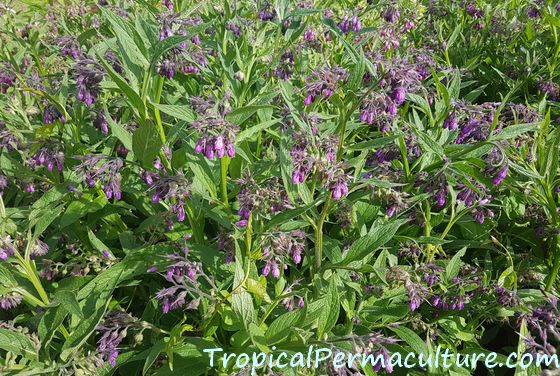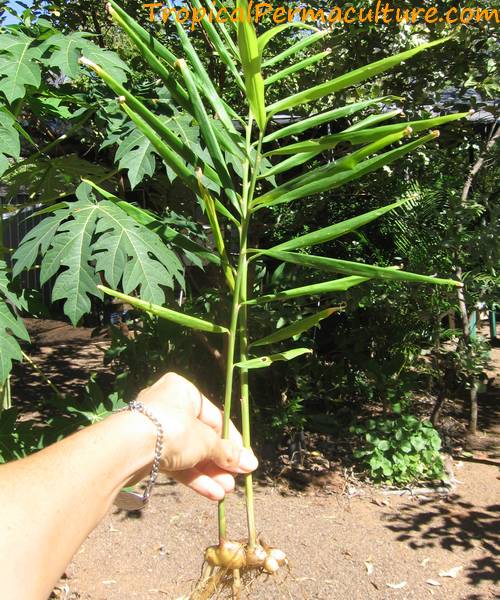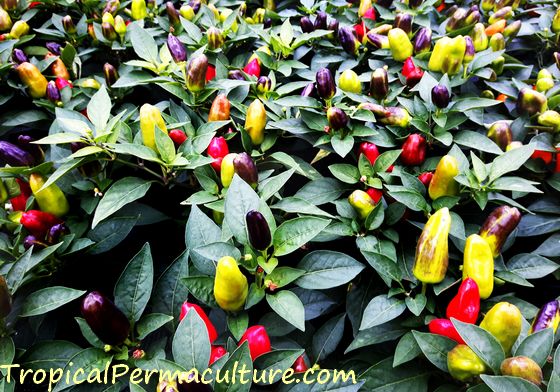Growing Borage (Borago officinalis)
How To Grow Borage With Two Different Methods
Growing borage can be done in two different ways: One involves a lot of work, the other no work at all.
Since this website is about using permaculture principles in home gardens, by working with nature rather than against it, and that way saving and eliminating a lot of work, we will talk mostly about how to grow borage the easy way. This method is well suited to natural gardens. (And permaculture gardens, naturally.)
If you prefer a neat garden, formal borders, clean rows in your vegetable beds etc., read to the bottom where I cover the other method as well.
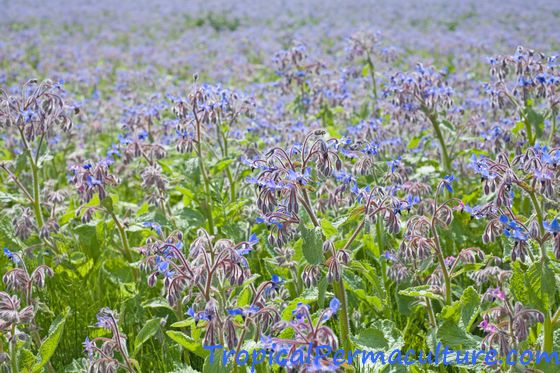 Borage growing in a field. (I won't be writing about growing a field of it!)
Borage growing in a field. (I won't be writing about growing a field of it!)What Is Borage And What Does It Look Like?
Borage is an annual herb and belongs to the borage family (Boraginaceae).
The perennial herb Comfrey belongs to the same family and the two plants have many similarities.
Borage grows large leaves covered with a fuzz of fine hairs that gives the leaves a silvery or grey appearance...
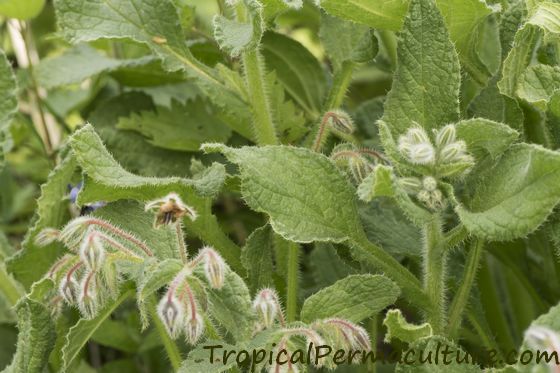
...and droopy bunches of flowers.
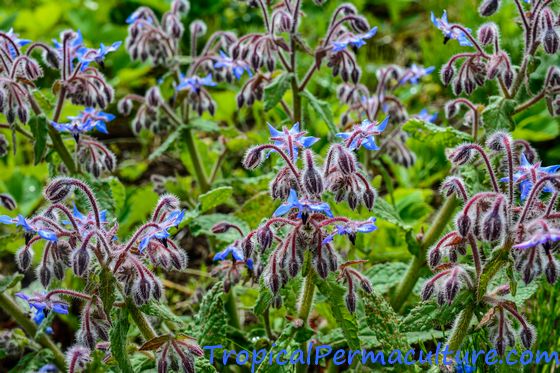
Where comfrey flowers are bell shaped and come in many shades, borage flowers are star shaped and have only one colour: a bright blue that is very attractive especially to bees but also to other pollinating and beneficial insects.
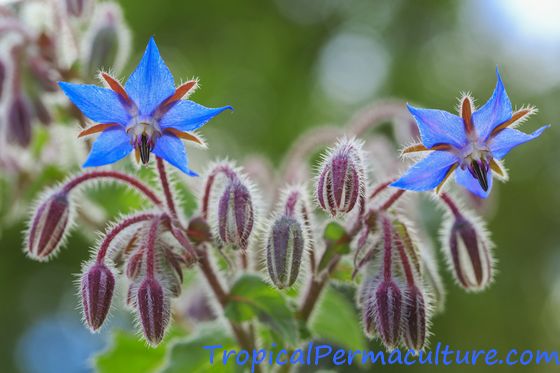
The bees really, REALLY love borage. It might just be their favourite flower of all.
As the flowers fade, they turn purple and eventually pink.
Borage also grows a tap root, but because it is an annual plant this root does not grow as deep as comfrey roots do.
A happy borage plant can grow quite tall, up to almost a metre (3 feet) in height. If given the space (and nutrients, sunlight and water) it will become 30cm (18 in) wide or wider.
Borage tends to grow somewhat gangly and is prone to falling over.
Both the borage flowers and the leaves are edible. More on that below.
What Borage Likes And Dislikes
Despite its soft stems and leaves and apart from its tendency to fall over, borage is a surprisingly tough plant.
Borage can handle a wide range of temperatures, from mild frosts to blistering heat, though it will need enough water to deal with the heat.
Humidity does not matter. You can grow borage in pretty much any climate.
If your winters are mild, the supposedly annual plant may survive and regrow the next year.
If you live in the tropics, your borage will do best during the dry season.
Borage does need free draining soil. If your garden tends to be boggy it should go in your raised beds.
Because of its deep tap root borage can mine deeper soil layers for nutrients, so it also grows in poorer soils. In fact, borage prefers soils that aren't too rich. Plenty of organic matter content is ideal to make the soil drain well and provide a slightly acidic pH, but you don't need to add any fertilizer on top. Too much nitrogen will give you an even softer plant, lots of leaves and few flowers, so don't add manure or other nitrogen rich fertilizers.
Borage grows best in full sun. You can also grow it in partial shade but aim for sun for at least half the day. The less sun borage gets the lankier it will be and the easier it will fall over. It also won't produce as many flowers.
Borage does need a bit of space. As with sun, if it doesn't get it, it will grow tall and thin. But if it is grown between other plants it doesn't matter as much as those will prevent it from being blown over with the slightest breeze.
Like comfrey, borage doesn't have any problems with diseases or pests. Because the leaves are covered densely with those fine hairs they are not attractive to chewing insects. No grasshoppers, caterpillars etc. seem to go near it.
The only issues that may arise are mildew and other fungal problems if borage is growing very densely and in heavy soil. But that is true for most plants.
How To Grow Borage The Easy Way
Borage is grown from seed, full stop. I have never seen borage in a nursery as a young plant. It is too easy to grow from seed and it does not transplant well. Things with tap roots never do.
(Mind you, cucurbits like zucchinis or pumpkins also grow easily from seed and don't transplant well. Starting them in pots can easily set them back if not planted out quickly enough. But nurseries sell seedlings anyway.)
The first time you grow borage in your garden you need to obtain seeds and you'll probably have a limited number of them. So you will be a bit more concerned about their welfare I imagine. (Trust me, you soon won't worry about that any more!)
The seeds are black, small, but big enough to handle individually. Stick them in the ground where you want them to grow, maybe 1-2cm deep (around 1/2 in), it doesn't really matter. In a cold climate, start the seeds after the last frost or at a later time. You can start new plants until late summer.
Borage seed comes up very reliably. It will take about one to two weeks for the seeds to germinate. The warmer the soil, the sooner they'll come up.
(You can help seeds to germinate quicker if you refrigerate them for two weeks beforehand. It makes them think they just went through a winter.)
Even the first two leaves will be fairly large already and your borage will grow quickly from there.
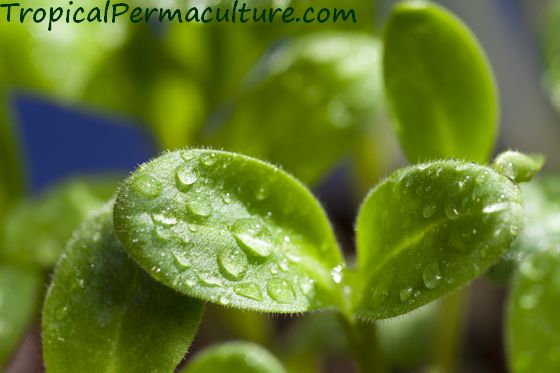
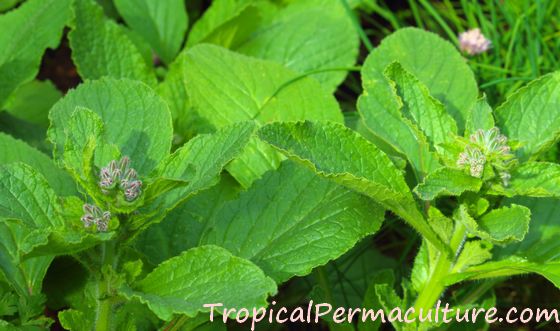
In the early days you should make sure that the soil does not dry out too much. Once the tap root reaches further down, it does not matter if the top soil dries out. Thanks to its deep tap root borage is fairly drought tolerant.
The plant will be fully grown and in flower in about eight weeks. The flowers do not open all at once, they appear gradually and the stems will continue to branch and grow more flowers. That means your borage will flower for a long time. If you still have plants in autumn, they will flower until it freezes.
It also means your borage will start producing seeds. If the flowers appear gradually, then so do the seeds. They fall off as soon as they are ready, and they will grow wherever they fall. If it is early in the season, you will have more fresh plants later in the year. If it is late, they will happily lie there over the winter and grow next spring.
And that's what makes it so easy to grow borage. You plant it once, and you will have borage all year round forever after, without ever doing anything again.
(Obviously, for this method to work for you, you need a fairly natural, wild garden, or at least garden area, where the borage can grow freely, wherever it likes, mixed in with other things. Though I find it also works in my more organized vegetable and herb garden. Borage just grows in between wherever it pops up.)
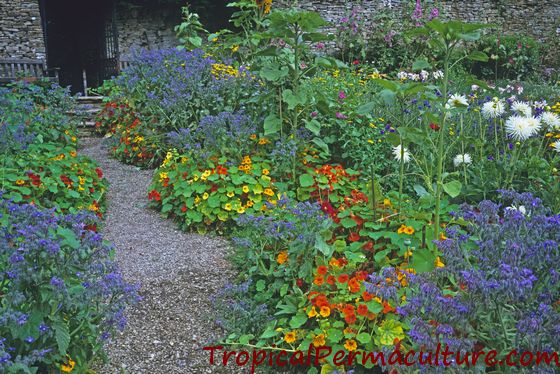 NOT my garden but very, very pretty nevertheless!
NOT my garden but very, very pretty nevertheless!Borage growing between nasturtiums with some sunflowers and dahlias because why not.
Borage plants become somewhat unsightly as they get older. If they aren't trimmed regularly they will begin to decline once they have reached the full flowering stage.
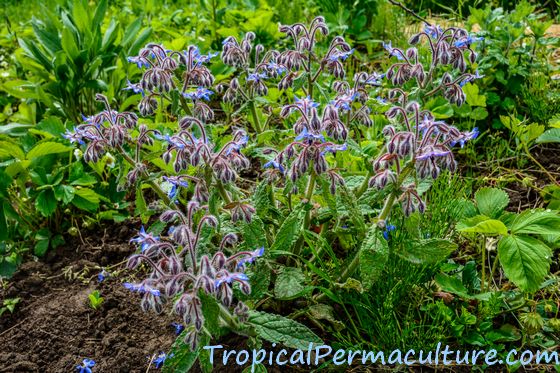 This borage plant is fully grown and will start to decline soon.
This borage plant is fully grown and will start to decline soon.Its tendency to fall over can be seen already.
Pulling them up and using the plant as mulch can transfer some seeds (and valuable nutrition!) to other garden areas as well.
If you have too much borage growing already, you can trim the plants down before they flower/set seed for use as mulch. That way the garden looks neat again and the plants will regrow.
(By the way, you may want to use gloves for that. The fine hairs are not as soft as they look!)
If you find too many borage seedlings growing in one place, or find them in places where you don't want them, they are very easy to pull up.
You can theoretically transplant those small volunteer seedlings, but you need to do it very early. Tap root, remember? Do it early, and dig them out deep enough and with enough soil attached. And don't be surprised if they still don't like being transplanted. Also, that's too much like work, so I don't do it.
How To Grow Borage The Cumbersome Way
You can grow borage the way we were taught in the old days vegetables and herbs should be grown. It involves a lot of (unnecessary) work, and this section is a bit tongue in cheek. However, you may want to use some of these tips on your borage plants regardless.
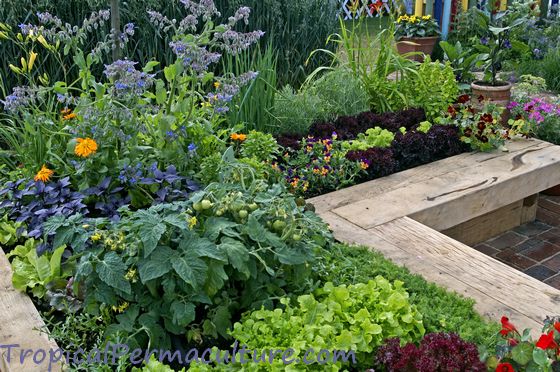 Neat vegetable garden with two flowering borage plants growing in the background.
Neat vegetable garden with two flowering borage plants growing in the background.Nothing wrong with that, is there? (Not my garden.)
Prepare a planting bed, loosen the soil, enrich it with compost, and then put in your borage seeds in neat rows, spacing them at least 30cm/1 foot apart.
(Alternatively, borage can be grown in containers, provided those are large enough to accommodate the tap root.)
Keep the bed weed free. Water it regularly.
To ensure a regular supply of borage leaves and seeds over the season, stagger your planting times, sowing fresh seeds every four weeks.
If you are impatient or have a very short growing season, you can even start borage seeds indoors, four to eight weeks before the last frost. (Like anyone knows when exactly that will be...)
You need to use (large!) biodegradable pots for this so you don't disturb the roots when planting your seedlings outside. Just put the whole pot in the ground.
When your seedlings are about 15cm/6 inches tall pinch out the tips. That makes for a bushier, sturdier plant.
Watch the plants once they start flowering. Once the flowers begin to fade, remove them. This regular deadheading will keep your borage plants flowering for longer and delay their inevitable decline and falling over.
By midsummer, prune back the whole plant by about half so it regrows fresh shoots.
If you want to collect borage seeds you also need to watch the plants closely, because the flowers open and the seeds ripen not all at the same time but one after another over weeks. Pick the seeds off individually or regularly shake them off of your plants. Alternatively, bag the whole, growing plant in fine gauze or something that lets light and air through to prevent the seeds from falling on the ground.
Remove the spent plants and add them to your compost pile.
Repeat every year.
Borage Garden Uses And Benefits
For several reasons borage is a great addition to any vegetable garden. (Not the least of which is that it makes the garden pretty.)
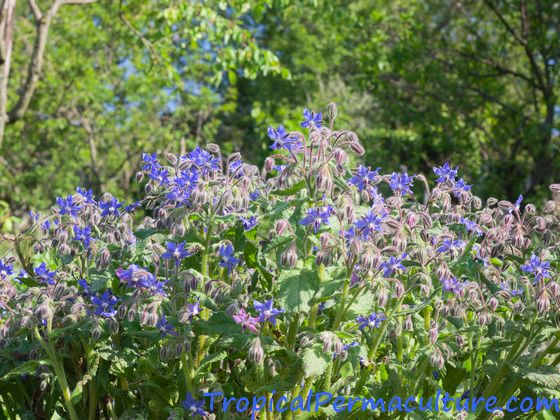 Borage growing prettily in a natural garden.
Borage growing prettily in a natural garden.
Borage is very attractive to bees so you can use it to entice more of them (and other pollinators) into garden areas where plants need pollinating.
Borage is a good companion for strawberries, making them stronger and also increasing their fruit because more bees will visit. The same goes for squash and pumpkins and the rest of the cucurbit family.
If grown next to tomatoes, borage is supposed to keep away tomato hornworm and also make the tomatoes taste better. (I have not scientifically tested this.)
Cabbage worm is also said to be put off if borage plants are growing nearby.
Generally, somehow borage makes any and all plants growing next to it more resistant to pests and diseases.
Actually, there is no solid research on any of this. It may or may not be true. Borage certainly doesn't seem to hurt anything so why not try it out? If generations of gardeners swear by it there will be something to it.
The other benefit to having borage in the garden is that, again like comfrey, and for the same reasons as comfrey, it is useful as mulch and as a compost ingredient. The deep tap root brings up nutrients from deeper soil layers, and those nutrients can be used to feed other plants. Prune or pull up old plants and use them as mulch around other plants that need a boost. The leaves will break down quickly. For that reason they can also be added to the compost heap to speed things up.
A prime spot where borage can grow very naturally would be around fruit trees. The trees benefit from the pollinators and the mulch but there is no danger of the borage overgrowing the trees, no matter how much it self seeds.
Culinary Uses Of Borage
While the leaves, stems and flowers of borage are all edible, borage isn't a staple in anyone's pantry I think. And that's probably good. Because borage contains pyrrolizidine alkaloids just like comfrey does, albeit in much smaller amounts. Still, you probably should not be eating very large amounts of borage leaves over a longer period. (This by the way is true for many other herbs as well.)
Having said that, the way borage is generally used you wouldn't be doing that anyway. As I wrote, it isn't exactly a staple. Small amounts are perfectly fine and very safe. I eat them pretty much daily.
The leaves have a refreshing and slightly salty cucumber flavour and can be used in salads, dips, sandwiches, soups or wherever else you'd like to add them. Your imagination is the limit here. Borage leaves don't keep well so it's best to cut them right when you need them. For most uses you'll probably want to chop them finely.
The youngest leaves are best as they are the most tender, they don't have the bristly hair yet, and they contain the least amount of alkaloids.
Leaves can also be steamed or sauteed and used like spinach, something I never tried. The leaves lose their spiky fur when cooked so you can use slightly older leaves, but it also means consuming a lot of them, so even if you fall in love with that dish, you shouldn't be eating it every day.
Stems can also be eaten as a vegetable. Simply peel, chop and prepare them like celery.
There is no point in drying borage leaves, they won't retain their flavour.
Personally, I like the flowers best. They have a fresh flavour similar to the leaves with a hint of sweetness added and they look beautiful in salads or as an edible garnish on any dish. You can also float them in beverages. If you want to impress your guests, freeze them in ice cubes to add to drinks. Gorgeous.
If you are handy in the kitchen (I am not), the flowers can be candied/crystallized to use as decoration on cakes and confectionery.
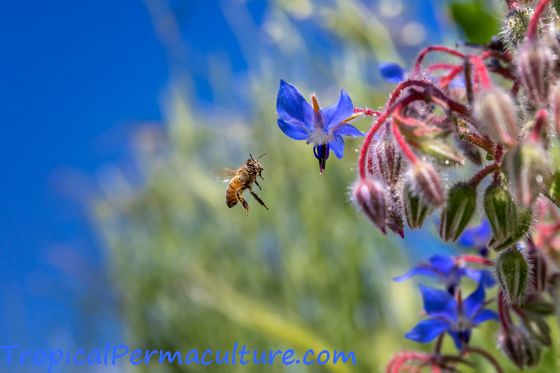
And last but not least, honey! Impossible to get without work, you will need to keep bees, obviously. But if you happen to, know that borage flowers make excellent tasting honey.
